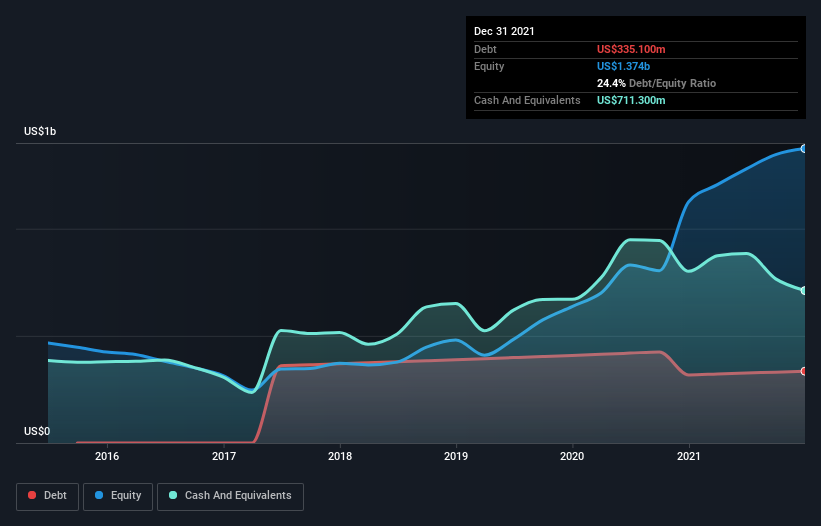Is Neurocrine Biosciences (NASDAQ:NBIX) A Risky Investment?
David Iben put it well when he said, 'Volatility is not a risk we care about. What we care about is avoiding the permanent loss of capital.' It's only natural to consider a company's balance sheet when you examine how risky it is, since debt is often involved when a business collapses. Importantly, Neurocrine Biosciences, Inc. (NASDAQ:NBIX) does carry debt. But the real question is whether this debt is making the company risky.
What Risk Does Debt Bring?
Debt and other liabilities become risky for a business when it cannot easily fulfill those obligations, either with free cash flow or by raising capital at an attractive price. In the worst case scenario, a company can go bankrupt if it cannot pay its creditors. However, a more frequent (but still costly) occurrence is where a company must issue shares at bargain-basement prices, permanently diluting shareholders, just to shore up its balance sheet. Having said that, the most common situation is where a company manages its debt reasonably well - and to its own advantage. The first step when considering a company's debt levels is to consider its cash and debt together.
View our latest analysis for Neurocrine Biosciences
What Is Neurocrine Biosciences's Net Debt?
You can click the graphic below for the historical numbers, but it shows that as of December 2021 Neurocrine Biosciences had US$335.1m of debt, an increase on US$317.9m, over one year. However, its balance sheet shows it holds US$711.3m in cash, so it actually has US$376.2m net cash.
How Healthy Is Neurocrine Biosciences' Balance Sheet?
The latest balance sheet data shows that Neurocrine Biosciences had liabilities of US$245.8m due within a year, and liabilities of US$452.7m falling due after that. On the other hand, it had cash of US$711.3m and US$185.5m worth of receivables due within a year. So it actually has US$198.3m more liquid assets than total liabilities.
This short term liquidity is a sign that Neurocrine Biosciences could probably pay off its debt with ease, as its balance sheet is far from stretched. Simply put, the fact that Neurocrine Biosciences has more cash than debt is arguably a good indication that it can manage its debt safely.
It is just as well that Neurocrine Biosciences's load is not too heavy, because its EBIT was down 37% over the last year. When a company sees its earnings tank, it can sometimes find its relationships with its lenders turn sour. When analysing debt levels, the balance sheet is the obvious place to start. But ultimately the future profitability of the business will decide if Neurocrine Biosciences can strengthen its balance sheet over time. So if you want to see what the professionals think, you might find this free report on analyst profit forecasts to be interesting.
Finally, while the tax-man may adore accounting profits, lenders only accept cold hard cash. Neurocrine Biosciences may have net cash on the balance sheet, but it is still interesting to look at how well the business converts its earnings before interest and tax (EBIT) to free cash flow, because that will influence both its need for, and its capacity to manage debt. Over the most recent three years, Neurocrine Biosciences recorded free cash flow worth 77% of its EBIT, which is around normal, given free cash flow excludes interest and tax. This free cash flow puts the company in a good position to pay down debt, when appropriate.
Summing up
While we empathize with investors who find debt concerning, you should keep in mind that Neurocrine Biosciences has net cash of US$376.2m, as well as more liquid assets than liabilities. The cherry on top was that in converted 77% of that EBIT to free cash flow, bringing in US$233m. So we don't have any problem with Neurocrine Biosciences's use of debt. There's no doubt that we learn most about debt from the balance sheet. But ultimately, every company can contain risks that exist outside of the balance sheet. For example - Neurocrine Biosciences has 2 warning signs we think you should be aware of.
At the end of the day, it's often better to focus on companies that are free from net debt. You can access our special list of such companies (all with a track record of profit growth). It's free.
Have feedback on this article? Concerned about the content? Get in touch with us directly. Alternatively, email editorial-team (at) simplywallst.com.
This article by Simply Wall St is general in nature. We provide commentary based on historical data and analyst forecasts only using an unbiased methodology and our articles are not intended to be financial advice. It does not constitute a recommendation to buy or sell any stock, and does not take account of your objectives, or your financial situation. We aim to bring you long-term focused analysis driven by fundamental data. Note that our analysis may not factor in the latest price-sensitive company announcements or qualitative material. Simply Wall St has no position in any stocks mentioned.

 Yahoo Finance
Yahoo Finance 